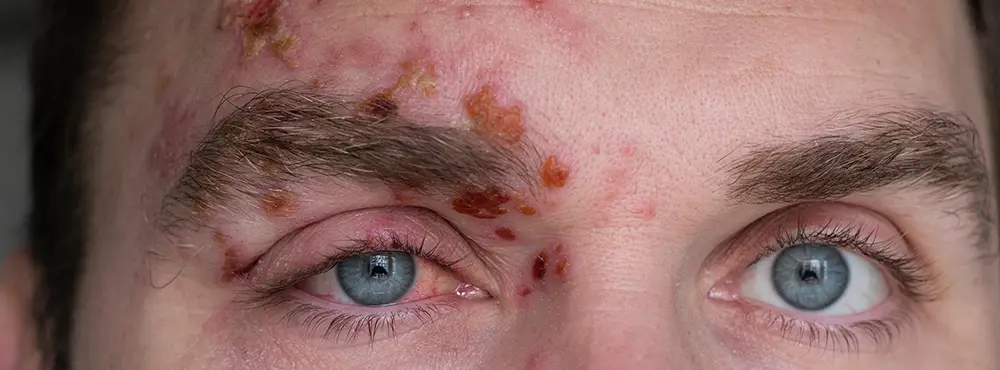Shingles of the eye are also known as ophthalmic herpes zoster or herpes zoster ophthalmicus. It is a viral infection which causes a painful, blistering rash to appear in or around the eye. Shingles commonly affect the body more than the eyes and are caused by the varicella-zoster virus, which is the same virus responsible for chickenpox.
Can you get chickenpox in your eye?
While you can't get chickenpox in your eye, the same virus which causes chickenpox can cause shingles which you can get in your eye.
Once chickenpox has gone away, the virus lays dormant in the body and can reactivate at any time, causing shingles.
Shingles can affect the facial nerves causing one to experience eye-related symptoms such as shingles in the eye.
What are symptoms of shingles in the eye?
Shingle symptoms include a blistering rash on the eyelids, forehead and possibly the tip or side of the nose. It may accompany a skin rash or show up weeks after the blistering skin rash disappears. Some may only experience ocular shingles without a shingles rash on the skin. However, it usually occurs in one eye on the side of the face with the rash. It usually follows once the shingles body rash has gone.
Other symptoms of shingles include:
- Burning sensation in the eye
- Throbbing pain in the eye
- Redness in and around the eye
- Watery eyes
- Blurry vision
- Light sensitivity (photophobia)
- Eye irritation
- Swelling on your eyelid, retina (the light-sensitive layer in the back of your eye) or cornea (the curved, transparent dome of tissue at the front of the eye)
If you experience one or more of the symptoms above, you should call your eye care professional and book an optical appointment. The sooner you treat these symptoms, the less likely you are to have long-term complications.
How long does shingles in the eye last?
Shingles in the eye can last for up to a few months. Your opththalmologist/eye care professional should check your eyes every few days at the beginning stages. Once the infection has been treated, they may be required to see you every 3-12 months to monitor your vision and check for scarring or glaucoma.
Is ocular shingles contagious?
Ocular shingles are not contagious despite stemming from the same virus which causes chickenpox (which is contagious).
You cannot catch shingles; however, you can spread the varicella-zoster virus to somebody who has never had chickenpox, and this can cause them to develop chickenpox.
Once one has contracted the varicella-zoster virus, it will stay in their body forever and can activate again years later, resulting in shingles or/and ocular shingles.
The virus only spreads through contact with unscabbed shingles blisters. It does not spread through saliva.
Complications of shingles in the eye
Shingles can cause complications such as pain, even after the rash has cleared up due to nerve damage caused by the virus (known as postherpetic neuralgia). This is more common in older adults. In most people it will get better over time.
Shingles can also cause swelling of the cornea, leaving permanent scars and swelling of the retina, which can increase the pressure inside the eye and lead to glaucoma.
In addition to this, shingles in the eye can result in:
- Corneal ulcers
- Scarring
- Acute retinal necrosis, which can lead to blindness
- Uveitis (internal inflammation of the eye)
It's important to treat ocular shingles immediately to avoid further long-term complications such as vision loss. If you suspect you have shingles, you should visit your GP or eye care professional/optician right away.
How is shingles in the eye diagnosed?
Your ophthalmologist will be able to diagnose shingles in the eye just by looking at the rash on your eyelids and surrounding areas. They might take a sample of the blister fluid to examine for the varicella-zoster virus.
They will also examine your cornea, retina, lens and other parts of your eye, looking for swelling and damage that may have been caused as a result of the virus.
Treatment of shingles in the eye
Treatment with antiviral medication (acyclovir, valacyclovir and famciclovir) is most commonly used by doctors when shingles affect the eyes. It can come in a liquid or tablet form and should be taken as soon as possible and within 72 hours of the skin rash breaking out.
Antiviral medication may treat shingles by:
- Preventing the virus from spreading
- Helping the blisters heal
- Speeding up the fading of the rash
- Relieving pain
If one has a weakened immune system, they may be admitted to the hospital for intravenous antiviral medication.
Shingles in the eye can also be managed with topical eye drops to reduce swelling. There are two main types of topical eye drops for shingles:
- Corticosteroid eye drops – these are steroid eye drops which can reduce further risks from shingles of the eye by reducing the eye inflammation caused by shingles.
- Pupil-dilating eye drops – these may be prescribed by your optician to relieve pain due to internal ocular inflammation as a result of shingles.
It is best to prevent shingles in the first place by getting the shingles vaccine. This is available on the NHS to people in their 70s.
How can you care for ocular shingles at home?
- Make sure to follow the medical advice of your doctor regarding prescriptions
- Avoid scratching or picking at any blisters
- Use a cold compress to relieve pain and itching
- Wait until the blisters have healed before you have close contact with people and avoid anybody most at risk such as pregnant women, young babies and those with a weakened immune system. The blisters contain the chicken pox virus which can be spread
Risk factors for shingles
Shingles in adults are typically more common than in children. It is especially common in people aged 50 and older. While it's unknown as to why the varicella-zoster virus reactivates, risk factors include:
- Being older
- Stress
- A weakened immune system due to a disease such as cancer, HIV or AIDS
- Being ill
- Having had chicken pox as a child
- Taking medications which weaken the immune system
Shingles pose a higher risk in certain groups of people such as:
- Pregnant women
- Premature babies
- Those with a weakened immune system
Quick links:
A guide to eye herpes
A guide to red eyes
A guide to eye infections
Disclaimer: The advice in this article is for informational purposes only and does not replace medical care or an in-person check-up. Please check with an eyecare professional before purchasing any products or remedies. For information on our article review process, please refer to our Editorial Policy.

 Offers
Offers Account
Account
 Favorite
Favorite
 Basket
Basket

 OFFERS
OFFERS
















